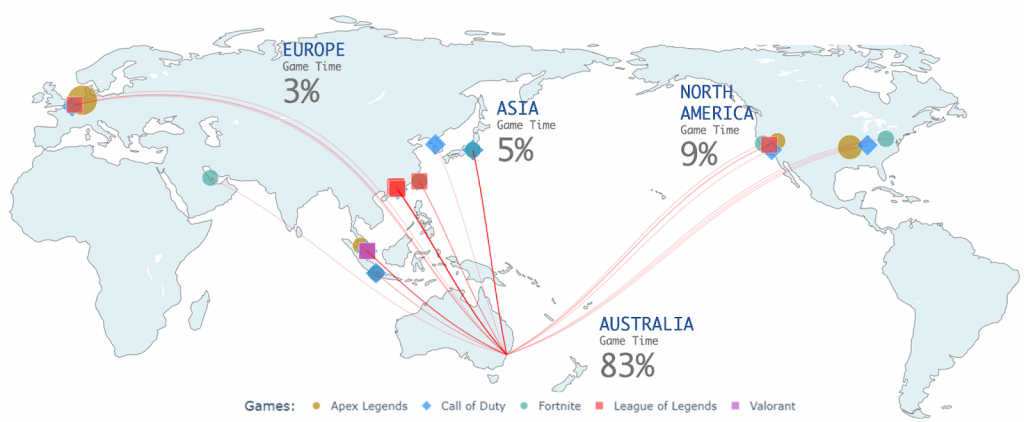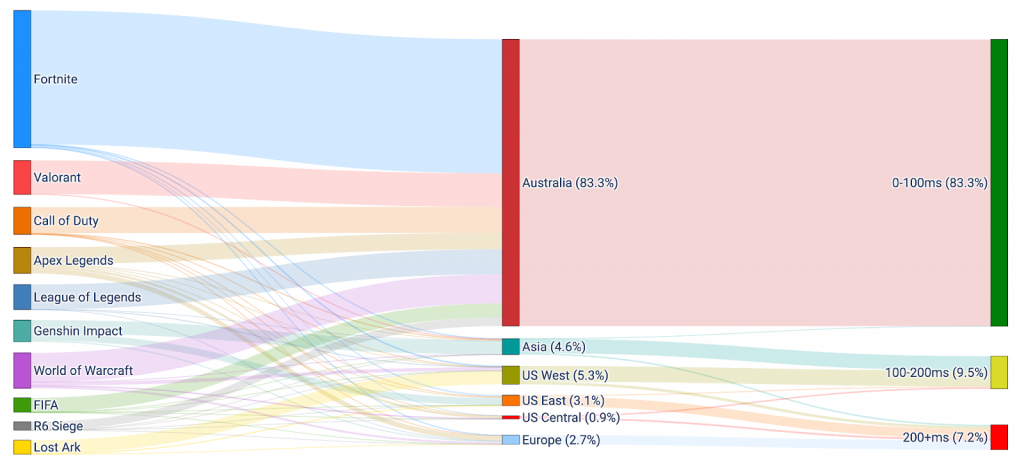
Online gaming generated USD 180B in 2021, three times as much as video streaming.
Gamers demand low network latency so they are not handicapped against other combatants, particularly in the multiplayer online battle arena (MOBA) and first-person shooter games like Fortnite, Call of Duty, and League of Legends. Shaving latency by tens of milliseconds (ms) can save an ISP substantial costs in complaints and churn while enhancing brand reputation in online forums.
Unfortunately, monitoring and managing gaming latencies are not straightforward. ISPs have almost no tools today to give them visibility into gaming latencies. Traditional Deep Packet Inspection (DPI) appliances target a wide range of applications spanning streaming, social media, and downloads, and have evolved to largely rely on hostnames found in DNS records and/or the TLS security certificates of a TCP connection.
Tracking modern games requires specialized machinery that can track UDP flows with no associated DNS or SNI information by matching multiple flow attributes in a stateful manner. Further, game servers are hosted in various cloud providers spread across the globe, and a different server may get picked for each game session depending on the time of day, players available, and team formations; therefore, one-off detection of IP ranges is not sufficient, it must be continuous. These factors have made it very challenging for ISPs to get visibility into gameplay behaviours, limiting their ability to tune their networks to improve gaming latencies.
To address this gap, we at the University of New South Wales have developed novel techniques to detect games, measure gaming latencies, and relate them to Internet routing paths by:
- Analysing popular games spanning genres, developers, and distributors to identify key game-specific attributes from network traffic.
- Developing a method to automatically construct game signatures and consolidate these into an efficient classification model that can identify gaming sessions with high accuracy and can scale to throughputs of up to multi-hundred gigabits per second.
- Performing BGP route and geolocation lookups, coupled with active ICMP and TCP latency measurements, to map the AS-path and latency to the detected game servers.
Doing so from different vantage points across Australia, we found that different ISPs serving gamers in the same city can offer radically different gaming latencies, influenced by their peering relationships and path selection preferences.
The following are some insights derived using our methods deployed across a few ISPs in Australia (including our university campus).
Game servers are located around the world
The Top-10 most popular games in Australia are spread across 30,000+ servers, located in 25 economies, 100+ cities, and 48 ASes. About 20% of game time is on overseas servers, reachable via multiple routing paths (Figure 1).

Latency impacts the gaming experience and varies by server location
Latency to game servers in Australia is below 100ms (Figure 2). Genshin Impact servers are predominantly in Japan (100-200ms) with some in the US east (200+ms), while Lost Ark servers are on the west coast of the US (100-200ms) or Europe (200+ms). Games hosted in Europe and the east coast of the US could become unplayable owing to significantly high latency.

The presence of multiple routing paths to overseas game servers allows ISPs to pick appropriate low latency paths to the servers. Our methods help ISPs to better optimize their networks and improve gaming latencies by enabling much-needed visibility into gaming behaviours and game server locations.
To learn more about the research, please refer to our paper. We have commercialized our work into a product called GameScope that can be readily installed in ISPs (more information is available). Alternatively, if you’re interested in gaming trends in the Asia Pacific region, you can read more about them in our OMG Report! Or connect with me on LinkedIn to have a chat!
Sharat Chandra Madanapalli is the Head of Data Science at Canopus Networks focusing on building data-driven products in the telecommunications industry.
The views expressed by the authors of this blog are their own and do not necessarily reflect the views of APNIC. Please note a Code of Conduct applies to this blog.
